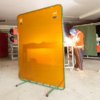mickoo
Western Thunderer
Next up on the bench for instruction photos is the A3 / A4 corridor tender.
The kit builds into either variant and the instructions will guide you though how to make the necessary changes for the A4 version. The tenders were all originally fitted to the A1/A3 class, however when the A4's came on stream the tenders were modified to work behind those engines, and remained so for the rest of their lives.
For this build I've opted for the original A1/A3 guise, if for nothing else other than it's the rarer (significantly shorter) of the periods and seems less modelled.
A quick clean up of the major parts, forming the cant rail and turn in curves results in a pretty quick build, like the streamlined non corridor tender built recently there are limited castings as yet, however it's pretty obvious where they go from the instruction drawings The objective of the photos is to try and show in 3D those areas that are best visualised by photos than deciphering 2D drawings.
The objective of the photos is to try and show in 3D those areas that are best visualised by photos than deciphering 2D drawings.
I've skipped the chassis for now as the streamlined one is near identical except the rear steps and vacuum pipe fitting, that sub assembly will be built for the photos but there is no need to build the full chassis for this current task. The full chassis will come later so that the whole kit can be eventually displayed at shows.
Only a couple of photos so far.


It doesn't take long to get to this stage, with cleaning and tack soldering, about six or seven hours, the tank top is only temporarily fitted to brace the sides for cleaning; I also still need to add the left side hand rail and both side lamp irons and it's easier to solder those in with the tank top out of the way.
Enjoy
MD
The kit builds into either variant and the instructions will guide you though how to make the necessary changes for the A4 version. The tenders were all originally fitted to the A1/A3 class, however when the A4's came on stream the tenders were modified to work behind those engines, and remained so for the rest of their lives.
For this build I've opted for the original A1/A3 guise, if for nothing else other than it's the rarer (significantly shorter) of the periods and seems less modelled.
A quick clean up of the major parts, forming the cant rail and turn in curves results in a pretty quick build, like the streamlined non corridor tender built recently there are limited castings as yet, however it's pretty obvious where they go from the instruction drawings
 The objective of the photos is to try and show in 3D those areas that are best visualised by photos than deciphering 2D drawings.
The objective of the photos is to try and show in 3D those areas that are best visualised by photos than deciphering 2D drawings.I've skipped the chassis for now as the streamlined one is near identical except the rear steps and vacuum pipe fitting, that sub assembly will be built for the photos but there is no need to build the full chassis for this current task. The full chassis will come later so that the whole kit can be eventually displayed at shows.
Only a couple of photos so far.


It doesn't take long to get to this stage, with cleaning and tack soldering, about six or seven hours, the tank top is only temporarily fitted to brace the sides for cleaning; I also still need to add the left side hand rail and both side lamp irons and it's easier to solder those in with the tank top out of the way.
Enjoy
MD






 They're barely visible to the eye and only when the light catches it at certain angles, but that is the nature of bending such items.
They're barely visible to the eye and only when the light catches it at certain angles, but that is the nature of bending such items.









 so maybe a new lead and iron are in order, the base unit'll be ok I reckon.
so maybe a new lead and iron are in order, the base unit'll be ok I reckon.

